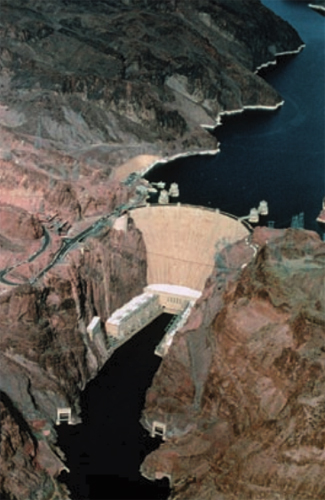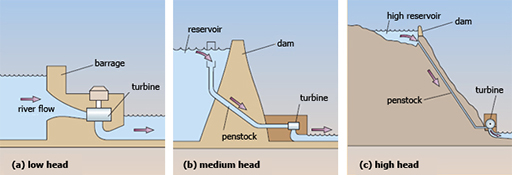6 Types of hydroelectric plant
Present-day hydroelectric installations range in capacity from a few hundred watts to more than 10,000 megawatts (10 GW).
We can classify installations by:
- the effective head of water
- the capacity – the rated power output
- the type of turbine used
- the location and type of dam, reservoir, etc.
The available head is an important determinant of the other factors, and the head and capacity together largely determine the type of plant and installation.
Hydroelectric installations can be classified as low, medium or high head. The boundaries are fuzzy, but high head usually implies an effective head of appreciably more than 100 metres and low head less than perhaps 10 metres. Figure 14 shows the main features of the three types. Low head ‘run-of-river’ power stations, having relatively little storage capacity, are dependent on the prevailing flow rate and can present problems of reliability if the flow varies greatly with the time of year or the weather.

The ‘medium head’ plant shown in Figure 15(b) and Figure 15 is typical of the very large hydroelectric installations with a dam at a narrow point in a river valley. The large reservoir behind the dam provides sufficient storage to meet demand in all but exceptionally dry conditions. Systems of this type don’t of course have to be on a gigantic scale, and quite small reservoirs can provide power for hydroelectric plant located below their dams.
To call the 220 metre head of the Hoover Dam ‘medium’ may seem surprising, but it illustrates the fact that the distinction between this and high-head systems lies more in the type of installation. The high-head plant shown in Figure 15(c) shows the difference with the entire reservoir well above the outflow, and the water flows through a long penstock (the channel, or pipe, carrying the flow) possibly passing through a mountain to reach the turbine.
With a high head, the flow needed for a given power is much smaller than for a low-head plant, so the turbines, generators and housing are more compact. But the long penstock adds to the cost, and the structure must be able to withstand the extremely high pressures below the great depth of water.
Various different types of turbine are used in hydro schemes, as you’ll see in the next section.

